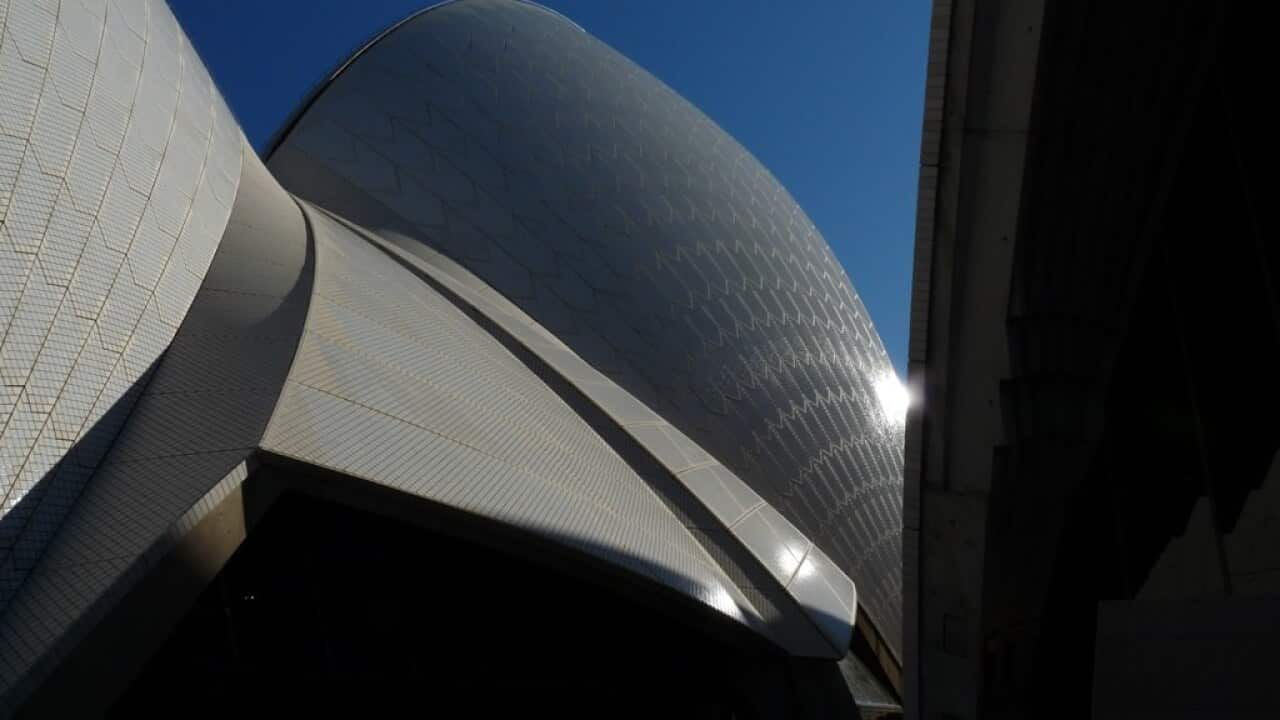TRANSCRIPT
A Sydney icon celebrates half a century this month.
There will be a month of festivities to mark 50 years of Sydney Opera House as a beloved harbour treasure, after it was first opened to the public on the 20th October in 1973. Its iconic sails are recognisable all over the world, but there's a lesser known Aboriginal history that marks the site once called Tubowgule, now known as Bennelong Point.
Quandamooka artist Megan Cope has created art installation 'Whispers' which is on display in three different parts of the Opera House for the entire month of October. The more than 85,000 oyster shells that form part of her work reference middens, which contain the rich history of Aboriginal rituals that used to take place on the very site where the Opera House now stands.
Cope shared the inspiration behind her work.
"A lot of the work I do it stems from this history that has occurred on our country, in Quandamooka Country. So a lot of our middens were robbed and burnt, the shell waste was burnt to use lime to build the foundations and cement for the colony. But really what middens are, are a location of place where families ate over a long period of time."
Angela attended the opening ceremony of the Opera House with her mother 50 years ago. Standing in front of two hundred timber Kinyingarra Guwinyanba poles covered in oyster shells, Angela told SBS she welcomes the historical and cultural Aboriginal references commemorated in this work.
"I guess it shows a change in attitude, because like 50 years ago you come in for the opening of the Opera House, but there was no recognition of in that whole ceremony on that day, there was no recognition of Indigenous ownership, or that anyone was here. It was very much the Queen, and white development kind of celebration. So this shows a very different light from 50 years ago. There would have been plenty middens here so to remind people of what had been here before and what would still be underneath the Opera House if you went digging, I think that brings the past and present together quite well."
Cope's reference to Aboriginal middens is important.
She says there are varying definitions of middens, but for Aboriginal people they are evidence of past hunting, gathering and food processing activities within a particular area. Cope says there are records citing the middens at Sydney's Opera House were around 100 metres long and up to 12 metres high.
"That for me is really important because when you grow up Aboriginal in this country we've often been antagonised or told we didn't have architecture and we didn't have this and that. And there are a lot of things that people say to kind of justify the colonial violence that occurred, and justify the continued extraction of our Country. So I'm interested in the material politics attached to place. So I guess these works really focus on oyster middens and Saltwater Country."
Sarah was also moved by this cultural and historical reference displayed across one of Sydney's most famous landmarks.
"It's just such a powerful reminder that this was an important gathering place for Aboriginal people. We did know it was drawing reference to middens, so the way people would gather and collect oyster shells, oysters, and eat them, and then they would become a big pile of oyster shells. And you can find middens all over the country, we've certainly seen them when we've been out and about ourselves. So to see them here is an amazing reminder that this was a location where people would have collected and eaten, and feasted and celebrated, and left behind remnants of that in the shells."
Others, like John, were also admiring the structural elements of the artwork.
“I think it's really, really nice. I'm an industrial designer so I'm just looking at how it's constructed but I think it's really beautiful. I think of food, I think of the history of Australia, Aboriginal culture. And yeah, you know, obviously it's an important time. I hope it has some impact. I'm sure that's why it's here."
Cope says she soon realised she would need the help of many volunteers to make her work a reality. More than 3 thousand volunteers have helped in the process of creating the installation over the past year, working together to clean, polish, drill and thread thousands of shells by hand.
"You know when I came up with the design and kind of realised the scale required to sit gently and respectfully with the Opera House, because it's such an enormous beautiful building - cultural site for everyone these days. Once we had done those drawings to scale and done some site measures I knew we would need a lot of shells. And I originally thought we would need about 200,000. But once we had done the maths I was quite relieved to find it was only about 85,000. So it's obvious we only had really 5 months to produce the works, so it was impossible to do that alone. And I also really enjoy inviting people into the studio, and inviting people into that space."
Many tourists were also fascinated to observe the tens of thousands of oyster shells that formed in a pile on the upper forecourt of the Opera House.
Nikita, who is visiting from Toronto, told SBS the art work is a reminder of the importance of preserving First Nations culture all around the world.
"We're from Toronto so we have a similar, well not a similar, but a similar experience with First Nations people there, and their relations with the government. So just a good thought to see it brought up here. And to see their place is mentioned more. Similar there where you see some of that culture is disappearing and it's nice to see it being brought to the forefront with installations like these, and just I think it spreads more awareness to folks, to people that aren't aware of their history. And it probably encourages a few people to do some research. And I think that's a good thing."
David also feels as though it imbues Sydney with a greater depth of historical truth.
"This is a reminder of the fruit of the sea that people relied on for their nourishment. And also the way that the storage of the shells have been represented here, shows there's a whole story of humanity and our community life that's worth remembering and that's what that brings back to us today. Well as a visitor to Australia, the Opera House is world-famous for all its sort of creativity, its music, its representations and its beauty as a building. So the way this particular part of the installation has worked outside the building with the bridge behind and the two flags above the bridge is very moving indeed."
It's these conversations Cope hopes to inspire, not only for the month the work is on display at Sydney Opera House, but also into the future.
"I hope that they see our culture, I hope they recognise an Aboriginal presence at such a significant cultural site. And you know I hope that they have an opportunity to see the past in the midden form, and then also consider the future with my Kinyingarra poles located at the front, so we can think about the plight of oyster reefs globally. So I'm hoping that we can have a bit of a connection to past, present and future."













